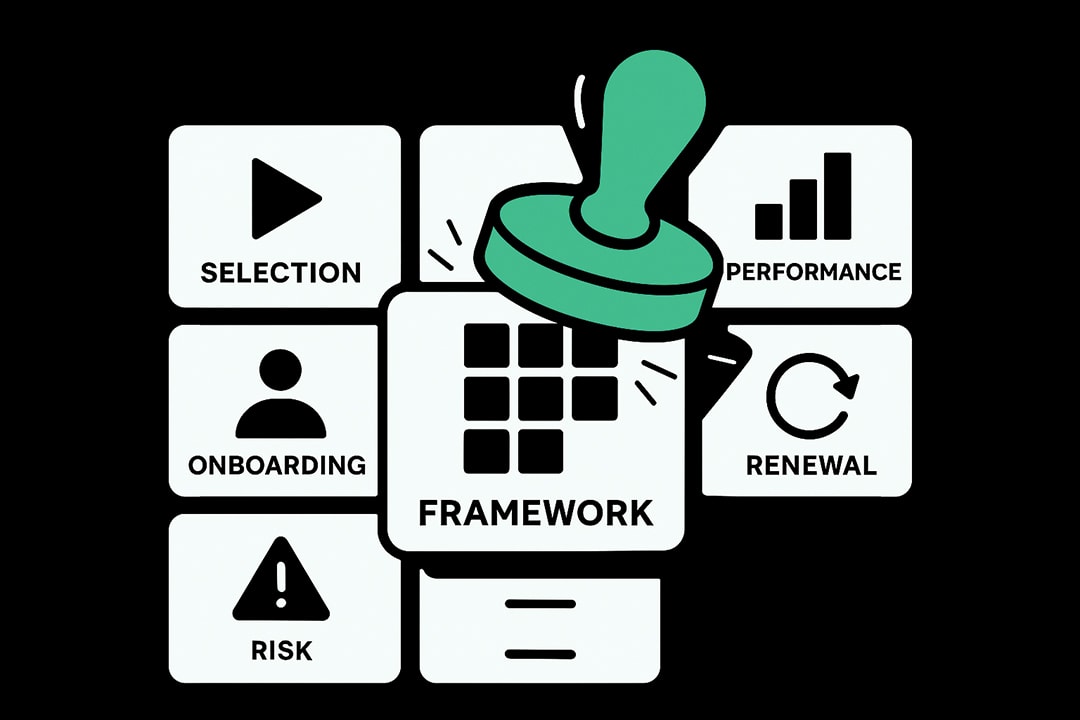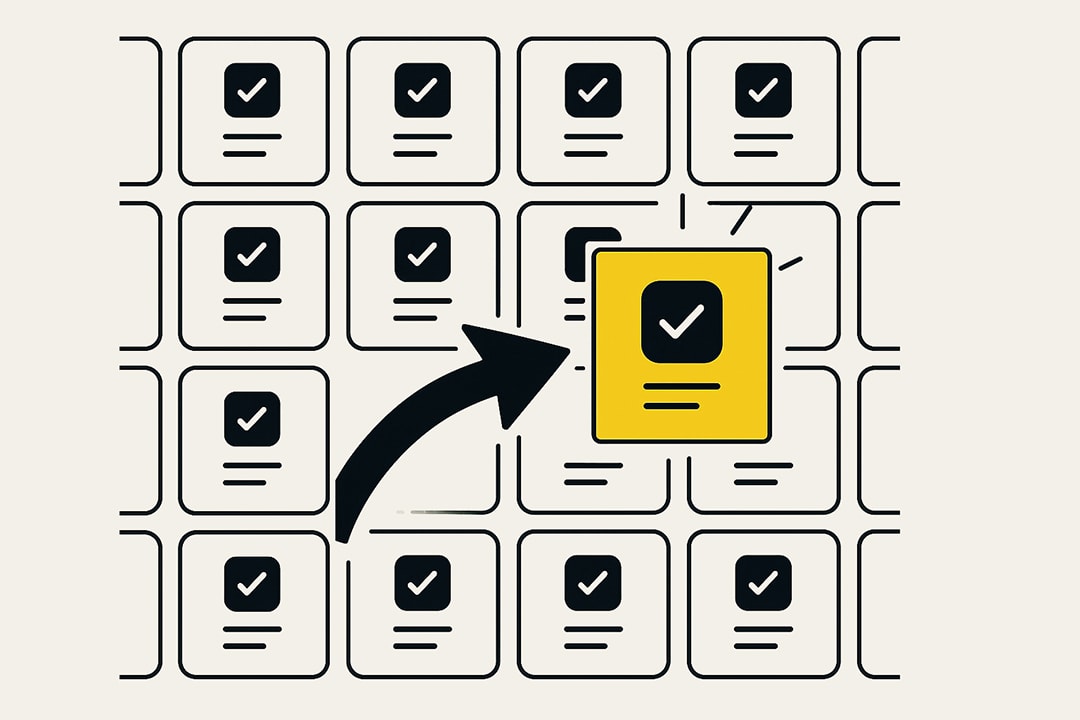Vendor Management in IT: A Practical Guide for Leaders
Learn what vendor management is in IT, who owns it, how to improve performance, and why disciplined vendor selection drives faster, safer outcomes.

What is Vendor Management in IT? A Complete Guide for Technology Leaders
What is vendor management in IT? It's the operating system for how technology teams plan, run, and improve third-party relationships.
Think intake, vendor selection, due diligence, contracting, onboarding, performance reviews, renewals, and offboarding—managed as one continuous loop through a vendor management system.
Why does that matter? Because every external tool touches your data, users, and uptime. Without disciplined IT vendor management, risk rises, costs drift, and decisions stall.
How is IT different from generic procurement? Integrations, data flows, and reliability targets make or break outcomes.
Does the product fit your SSO, logging, and data model? Can it meet latency and availability targets during peak loads?
Can you audit who touched what and when? Vendor management answers these questions with evidence, not opinions.
Where does vendor selection fit? It's the gate between intent and commitment.
The goal isn't to crown the best demo—it's to verify fit against real workflows and nonfunctional needs.
How do you keep that fair? Use scripts, scenario scoring, and right-sized proofs, then document trade-offs. Done well, vendor selection produces a decision you can defend to security, finance, and auditors.
What does day-to-day vendor management include? A standard intake to prevent tool sprawl.
Clear owners for value, security, and costs. KPIs tied to the business case. Continuous risk checks don't drown anyone in questionnaires.
Contract terms you can measure and enforce. And a predictable renewal rhythm. Ask a hard question: if a vendor missed its SLA, can you prove it and claim credits? Strong IT vendor management makes the answer "yes," every time.
What is the payoff? Faster approvals, fewer surprises, and cleaner handoffs from evaluation to operations.
Vendor selection becomes quicker and more objective. Renewals start with facts, not friction. And when tools need to be replaced, offboarding is safe and complete.
The simple test: if a new stakeholder asked, "Why this vendor, at this price, with these terms?"—could the records answer in minutes? That's the standard effective vendor management sets.
Why vendor management should be important for IT leaders
Why should vendor management matter to an IT leader already stretched thin? Because every vendor decision affects security, uptime, spend, and credibility.
When incidents happen, who answers first—security, finance, or IT? Strong IT vendor management gives each the same facts, fast.
How does it reduce risk without slowing delivery? By making risk continuous and right-sized. Are attestations current? Did the vendor add a new subprocessor? Did a cert expire?
With disciplined vendor management, these answers are tracked, alerted, and acted on before they become incidents through automated vendor management software.
What about cost control? Licenses drift, SKUs multiply, and shelfware hides in the long tail.
Can you prove unit economics—cost per active user or feature—before renewal? With consistent KPIs and usage data, vendor management turns "we think" into "we know," and negotiations start from reality, not list price theater.
Does it actually speed decisions? Yes—when intake, evaluation, approvals, and renewals follow the same path every time.
Are roles clear? Are criteria weighted? Are demos scripted? A clean playbook compresses the cycle and prevents the late-stage rework that burns calendar and goodwill.
How does it help in the boardroom or during audits? Evidence. Can you show the rationale for vendor selection, the controls in place, the SLA results, and what changed at renewal?
Vendor management creates an auditable trail that stands up to scrutiny—and protects teams from second-guessing after the fact.
Bottom line: vendor management is leverage. It protects the environment, trims waste, accelerates delivery, and makes vendor selection defensible.
For IT leaders, it's the difference between controlling the portfolio and being controlled by it. Modern vendor management systems make this control scalable and sustainable.
What is the role of vendor management in IT operations?
What is vendor management expected to do day to day? Turn intent into outcomes with guardrails.
That means a consistent path from intake to vendor selection, then into contracting, onboarding, operations, and renewal—without losing facts or ownership along the way.
How does it start? Standardized intake prevents tool sprawl and misaligned buys. Are outcomes clear, data classified, and existing options checked?
With disciplined IT vendor management, intake routes by risk and creates a clean brief for vendor selection.
What keeps decisions objective? A documented vendor selection process. Are scenarios defined, weights agreed, demos scripted, and evidence captured?
Objective scoring and right‑sized due diligence make selections defensible and fast—especially when supported by vendor management software.
How does it protect production? Contracting and onboarding translate decisions into enforceable terms and safe setups. Are SLAs measurable, credits enforceable, and renewal windows tracked?
Are SSO, logging, backups, and support paths live at go‑live? Vendor management makes these table stakes, not wish lists.
How is value proven? Performance reviews compare uptime, MTTR, adoption, and outcome KPIs to the business case. Are unit economics trending in the right direction?
Are gaps tied to actions and owners? IT vendor management keeps score and drives fixes.
What prevents surprises later? Continuous risk checks and renewal discipline. Are attestations current, subprocessors updated, and exceptions expiring?
Do renewals start with usage, benchmarks, and risk deltas? With tight vendor management, the answer is yes—and the portfolio stays under control.
Key components of an effective vendor management system
What makes a vendor management system effective? It unifies scattered data, automates repetitive tasks, and surfaces decisions when they matter.
Centralized vendor inventory: Every vendor, owner, contract, risk tier, data classification, renewal date, and integration point lives in one place. No spreadsheets, no email chains—just a single source of truth that makes IT vendor management measurable.
Risk and compliance tracking: Automated alerts for expiring certifications (SOC 2, ISO 27001), subprocessor changes, security rating drops, and overdue evidence. Risk becomes continuous, not annual, through intelligent vendor management software.
Contract and renewal management: Store contracts, track key terms (SLAs, price caps, data rights, exit clauses), and trigger renewal workflows 270/180/90 days out. Link contract terms to actual performance so vendor management negotiations start with facts.
Performance monitoring: Integrate with APM, SIEM, ITSM, and product analytics to track SLA attainment, incident counts, MTTR, and adoption metrics. Scorecards update automatically, making vendor performance reviews data-driven.
Financial visibility: Track spend, usage, license allocation, and unit economics. Flag shelfware, dormant accounts, and overlapping tools. Prove ROI and cost avoidance to finance and the C-suite.
Workflow automation: Route intake by risk tier, assign owners, trigger approvals, schedule reviews, and escalate exceptions. Automation keeps IT vendor management moving without manual chasing.
Audit trail and reporting: Every decision, exception, mitigation, and change is timestamped and linked to owners. Dashboards show tiering, risk heatmaps, renewal pipeline, and compliance status. This makes vendor management defensible under scrutiny.
How to improve vendor performance through better IT vendor management
How do vendors deliver outcomes consistently? Set clear targets, observe real usage, and act fast on gaps.
Vendor management turns this into a loop: define, measure, review, correct, and renegotiate. When the loop runs on evidence, vendor performance improves, and stays improved.
Define measurable outcomes from day one
Are success metrics explicit and observable? Lock in uptime, MTTR, latency, error budgets, adoption, and outcome KPIs in the contract. Tie each SLA to telemetry you already collect (APM, SIEM, ITSM, product analytics). If it can't be measured, it won't be managed through effective IT vendor management.
Instrument before launch
Are identity, logging, and monitoring ready? Enforce SSO/SCIM, admin boundaries, audit logs, and alerting before production use. Baseline key metrics in the first 30 days so trend lines are meaningful at QBR. Modern vendor management systems track these baselines automatically.
Run a cadence that makes decisions, not decks
Are QBRs short and useful? Use a one-page health score blending reliability, adoption, value, and risk. Limit the meeting to decisions: invest, maintain, remediate, or replace. Convert talk into tickets with owners and due dates tracked in your vendor management software.
Use contractual levers—consistently
Do credits actually get applied? When SLAs miss, claim service credits and document them. Align future SLAs and reporting cadence to observed behavior. Over time, this shifts talk tracks from anecdotes to evidence—the hallmark of mature vendor management.
Right-size entitlements to kill shelfware
Are SKUs matched to reality? Review seats, tiers, and feature usage quarterly. Remove inactive users, downgrade underused tiers, and consolidate overlapping tools. Feed changes into renewal targets and the cost model. Strong IT vendor management reclaims 15-30% of software spend this way.
Enable the people who make it work
Do admins and users have what they need? Provide enablement for high-impact workflows, admin runbooks, escalation paths, and maintenance windows. Poor enablement looks like poor vendor performance; fix both through structured vendor management.
Escalate with structure, not emotion
Are incidents resolved and prevented? Require RCAs for repeat issues with concrete prevention steps. Track systemic fixes (patch SLAs, capacity increases, rate-limit changes) and re-test in the next review. Document everything in your vendor management system.
Align roadmap to business value
Are vendor roadmaps useful to you? Maintain a joint backlog with ranked asks tied to outcome KPIs. Use renewals to reinforce priorities—trade term length or references for committed roadmap items and delivery timelines.
Tie performance to renewal leverage
Do renewals start with facts? Build a renewal packet with usage, KPI trends, incidents, credits, and benchmarks. If value lags, renegotiate terms, downsize, or replace. If value leads, scale with better pricing and protections. This is where vendor management pays for itself.
Close the loop with transparent reporting
Can stakeholders see the same truth? Publish a dashboard covering health scores, SLA attainment, adoption, unit economics, and open risks. Transparency removes surprises and accelerates decisions across IT vendor management.
The role of vendor selection in vendor management
Why does vendor selection matter so much? Because it sets the trajectory for everything that follows—contract terms, onboarding effort, integration risk, performance potential, and renewal leverage.
A disciplined vendor selection process reduces uncertainty upfront, so vendor management can focus on delivery instead of firefighting.
What does "disciplined" look like? Start with problem statements, not product wish lists. Translate outcomes into scenarios with measurable acceptance tests.
Weight criteria by business impact and risk. Script demos and require execution against your data and identity stack. Capture evidence—recordings, logs, configs—and score with anchored rubrics stored in your vendor management system.
This turns vendor selection from persuasion into proof.
How does vendor selection lower long‑term cost? By testing workflow fit and unit economics before signature. Can the tool hit latency and availability targets on real paths?
Does identity (SSO/SCIM), logging, and data lifecycle work as required? What's the cost per active user or transaction at expected scale? Answering these during vendor selection avoids expensive rework and weak renegotiations later in the IT vendor management lifecycle.
Where do security and compliance fit? Upfront and right‑sized. Gate on non‑negotiables (e.g., SOC 2/ISO, DPA, residency, subprocessors) before deep evaluation.
For higher‑risk categories, run a targeted proof to validate auth flows, audit trails, encryption behavior, and API boundaries. Vendor selection should produce a risk log with owners and expiry, not a pile of unchecked questionnaires.
When should the vendor selection process go deep vs. move fast?
Match depth to impact:
Low risk and clear fit: curated shortlist + scripted demos; lean diligence tracked in vendor management software.
Integration‑heavy or regulated: add a use‑case matrix and targeted POC with documented results.
Strategic platform decisions: full package: matrix, POC, benchmarked TCO/ROI, and comprehensive risk assessment.
What artifacts must carry forward in your vendor management system?
Keep the requirements and weights, scenario scripts, completed scorecards, POC results, and the risk/exception log.
Add a short decision memo with trade‑offs, residual risks, and 30/60/90‑day outcomes. These become the backbone of onboarding checklists, QBR metrics, SLA enforcement, and renewal packets, closing the loop between vendor selection and ongoing vendor management.
How does vendor selection protect leverage at renewal? Evidence. Usage trends, KPI attainment, SLA credits earned, and resolved exceptions map directly back to the assumptions tested during evaluation.
If reality diverges, you have grounds to resize, renegotiate, or replace. If outcomes match or exceed plan, you can scale with confidence—and better terms through strategic IT vendor management.
Vendor selection failure modes to avoid
Feature counting instead of scenario fit leads to surprises in production.
Unscripted demos reward stagecraft, not operability.
Point‑in‑time risk checks miss changes in subprocessors or posture.
No unit economics model leaves you exposed to shelfware and price hikes.
Missing artifacts force teams to re‑discover context at onboarding and renewal.
Bottom line: vendor selection is not a one‑off gate; it's the foundation of the vendor management lifecycle. Treat it as a repeatable, evidence‑first process and the rest of IT vendor management becomes faster, cheaper, and more defensible.
Building a scalable vendor management framework
How do you scale vendor management without adding headcount? Build a framework that runs on process, tools, and clear ownership.
Standardize intake and tiering: Create a simple intake form capturing business outcome, data classification, integration scope, and regulatory requirements. Auto-assign risk tiers (critical/high/medium/low) that determine review depth, approval levels, and monitoring frequency.
Define stage gates with clear criteria: Map the vendor lifecycle—intake, selection, due diligence, contracting, onboarding, operations, renewal, exit—with explicit go/no-go criteria at each gate. Document these in your vendor management system so teams execute consistently.
Assign clear ownership: Every vendor needs a business owner (value), technical owner (integration/operations), and risk owner (security/compliance). Publish a RACI and enforce it through vendor management software workflows.
Automate the repetitive work: Set up automatic alerts for renewal windows, expiring certifications, dormant licenses, SLA breaches, and subprocessor changes. Let IT vendor management tools handle the chasing so people can focus on decisions.
Create reusable templates: Maintain standard artifacts—intake forms, evaluation scorecards, due diligence checklists, contract clause libraries, onboarding runbooks, QBR templates, and exit playbooks. Store them centrally so every engagement starts from best practice.
Instrument performance continuously: Integrate your vendor management system with APM, SIEM, ITSM, finance, and IAM systems. Pull SLA data, incident counts, usage metrics, and spend automatically. Make vendor performance visible without manual reporting.
Run rhythmic reviews: Monthly dashboards, quarterly business reviews with vendors, and annual portfolio health checks. Keep the cadence predictable and the data current so vendor management stays proactive.
Common vendor management challenges and solutions
Challenge: Shadow IT and tool sprawl
Solution: Enforce intake through procurement controls and SSO gating. Use vendor management software to discover unapproved tools through expense reports, SSO logs, and network traffic. Provide a fast-track approval process for low-risk tools so teams don't route around IT vendor management.
Challenge: Inconsistent vendor evaluation
Solution: Standardize scenario scripts, scoring rubrics, and evidence requirements by risk tier. Store all artifacts in your vendor management system so evaluations are comparable and defensible.
Challenge: Contract terms that can't be enforced
Solution: Define measurable SLAs tied to observable telemetry. Require service credit calculations, breach remedies, and notification timelines in contracts. Use vendor management software to track actual performance against commitments.
Challenge: Renewals that surprise finance
Solution: Set renewal alerts 270/180/90 days out in your vendor management system. Build decision packets with usage, KPI trends, incidents, benchmarks, and TCO. Start negotiations with data, not urgency.
Challenge: Scattered vendor data
Solution: Centralize everything—contracts, owners, risk assessments, performance data, renewal dates—in one vendor management system. Make it the single source of truth for IT vendor management.
Challenge: Manual tracking and reporting
Solution: Automate data collection from integrated systems. Generate dashboards and scorecards automatically. Let vendor management software handle the mechanics so teams focus on decisions and actions.
Closing thoughts
What does "good" look like in IT vendor management? A clear path from intent to outcomes, enforced by process and proof. Vendor selection is objective and fast.
Contracts reflect measurable reality. Onboarding is safe. Performance is tracked. Risk is continuous. Renewals start with facts.
How do teams get there? Standardize intake, define the vendor selection process, and require evidence at every step. Use scenario scoring, scripted demos, and targeted POCs to prove fit.
Track KPIs, unit economics, and exceptions with owners and expiry. Automate alerts for renewals and compliance through vendor management software. Document everything in your vendor management system.
What's the payoff? Fewer surprises, lower cost, better uptime, and cleaner audits.
When someone asks, "Why this vendor at this price with these terms?" the records answer in minutes. That's vendor management done right—and that's how IT leaders keep control of the stack while moving fast.
Strong IT vendor management isn't overhead—it's the operating system that makes third-party relationships predictable, defensible, and valuable. Build it once, run it consistently, and it becomes your strategic advantage.
Better vendor management begins with better vendor discovery
With TechnologyMatch, vendor discovery and selection become streamlined and noise-free, setting up the stage for better vendor management. Get matched with the right vendors and surf through our catalog of pre-vetted vendors.
FAQ
What is vendor management in IT?
Vendor management in IT is the end-to-end discipline for governing third-party tools and services across intake, vendor selection, due diligence, contracting, onboarding, performance, risk, and renewals. It standardizes decisions, controls cost and risk, and creates an auditable record.
Why is vendor management critical for IT leaders?
It reduces security and compliance risk, curbs tool sprawl and spend, speeds approvals with a repeatable vendor selection process, and strengthens renewal leverage through measurable performance and usage data. The payoff is faster, safer outcomes.
Who are the key stakeholders in vendor management?
Core stakeholders include the business owner, technical owner/architecture, security/privacy (GRC), procurement/VMO, legal, finance, data/platform/operations, and an executive sponsor. Clear roles keep vendor selection and ongoing management accountable and efficient.
How does vendor selection fit into vendor management?
Vendor selection is the decision gate: translate outcomes into scenarios, weight criteria, run scripted demos with your data, and add targeted POCs for high-risk assumptions. This produces an objective decision and the artifacts needed for contracting, onboarding, and renewals.
How can IT improve vendor performance with better management?
Define measurable KPIs (uptime, MTTR, adoption, outcome KPIs), enable telemetry before go-live, run concise QBRs with a health score, enforce SLA credits, right-size SKUs, and align roadmaps to business value. Tie results to renewal decisions for continuous improvement.





